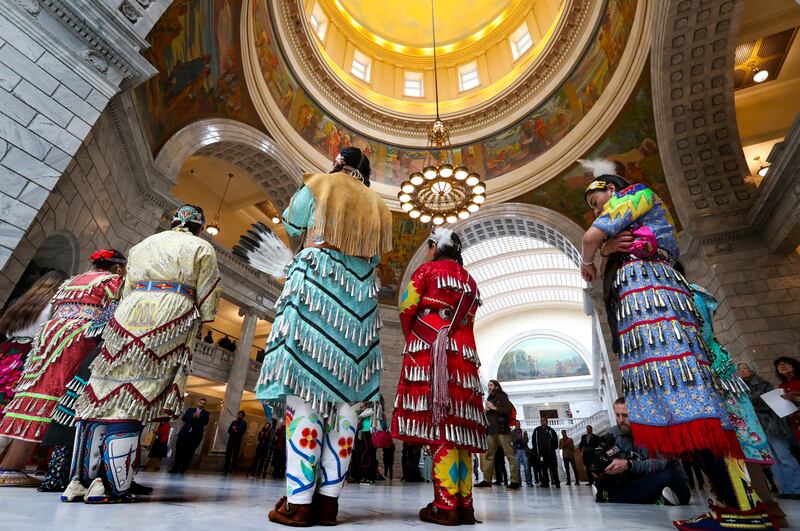As it is Native American Heritage month and Thanksgiving is approaching, I have a heightened awareness of my Navajo/Diné identity. Romanticized images of Pilgrims and Indians holding hands abound and children will recreate that mythical meal. Too often Native people are invisible, remembered only as we tell stories of Puritans and Pocahontas. So as some commemorate that harvest feast from 1621, and others join with family — not considering it “Thanksgiving,” but “giving thanks” — I ask that we look back and consider simple truths that acknowledge who were the stewards of the land on which we work, build and play, long before the Puritans arrived.
Here are three simple truth-tellings that I hope we, as Americans, understand about the lands we occupy:
- Recognize what is truth and what is myth about Pilgrim/Indian relations, which should be referred to as Pilgrim/Wampanoag relations. We know the two groups came together to share a meal after the native Wampanoag taught the settlers how to plant corn, where to fish and how to survive harsh New England winters. The truth is their relationship was complicated. Many of the native tribes had already been decimated by smallpox and violence brought by European voyagers. Massasoit thought an alliance with the whites would help him in his conflicts with other tribes. He was wrong. By 1691, some estimate the population of Indigenous peoples had declined by 90%. And if you chose to commemorate the first Thanksgiving, be clear who the parties were: English refugees and Wampanoag. Indians are not a monolith, with over 500 distinctive tribes and at least 175 languages.
- Understand that the concept of land “ownership” is a white construct, not an Indigenous one. Here in Utah, the land was occupied by a variety of Native peoples, most of who were nomadic which caused further confusion about land ownership. For example, the Utes spent summers in the mountains, where water and food were plentiful, then wintered by rivers in Provo and Duchesne. So a settler might find their winter camp unoccupied, erroneously assume no one lived there, and move into the camp. Native people saw the land as a gift that gave them life; they in turn tended the land, building a symbiotic relationship that continued with their posterity.
- Know that the lands that support your home, work, church and schools were once under the care and stewardship of one or more of Utah’s eight recognized tribes: Confederated Tribes of Goshute, Paiute Indian Tribe of Utah, San Juan Southern Paiute Tribe, Northwestern Band of Shoshone Nation, Skull Valley Band of Goshute, Ute Indian Tribe of the Uintah and Ouray Reservation, Ute Mountain Ute Tribe and the Navajo Nation.
Reflect on these truths and consider: how can you honor the land on which you reside? How can you be a good steward of the beautiful state in which you live? How can you show thankfulness to the land that has so freely offered its blessings to you?
To pay this respect, and bring awareness to the history, many people have begun offering a verbal or written “Land Acknowledgement.” This simple yet profound act asks each of us to recognize previous stewards of the land on which we now reside and provides an opportunity to teach our children to honor the sacred nature of the land. The National Museum of the American Indian uses this phrasing:
“We gratefully acknowledge the Native peoples on whose ancestral homelands we gather, as well as the diverse and vibrant Native communities who make their home here today.”
A white colleague of mine has this at the end of his emails: “BYU sits on the traditional homelands of the Ute, Paiute and Shoshone peoples.” Every time we communicate via email, I feel seen. I urge you to try some version of honoring the land and its preceding inhabitants in whatever way feels authentic.
I ask you to explore the truths presented here, and see how you can be part of a conversation that does not deny the lived experience of millions of Native people. Take a moment to learn the name of the tribe(s) who originally inhabited the land where you live. And as you honor the giving of thanks or a harvest feast, let your gratitude expand to remember the Indigenous people who gave their bounty for others — not just fish and corn, but their lands, and often their lives.
Brenda Beyal is a Navajo/Diné wife, mother and teacher. She resides in Mapleton and leads the Native American Curriculum Initiative for the BYU ARTS Partnership. Heather Sundahl is a writer and editor for the BYU ARTS Partnership, the Utah Women & Leadership Project, and historian for Exponent II. A previous version of this article was published by the BYU ARTS Partnership.

